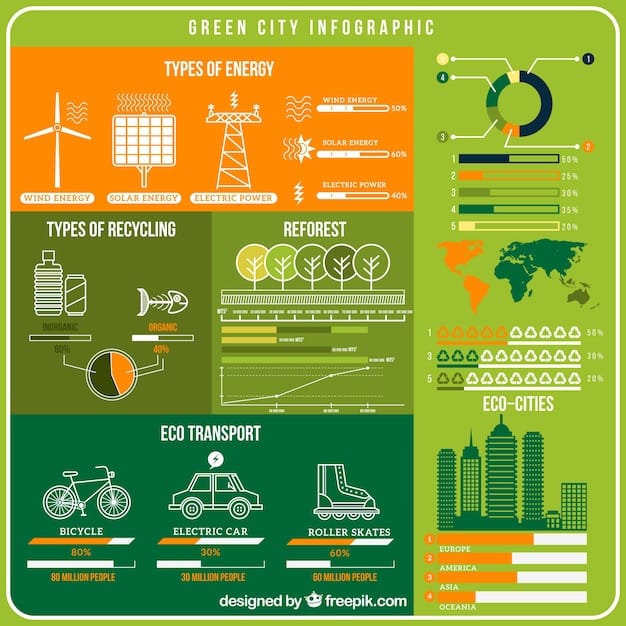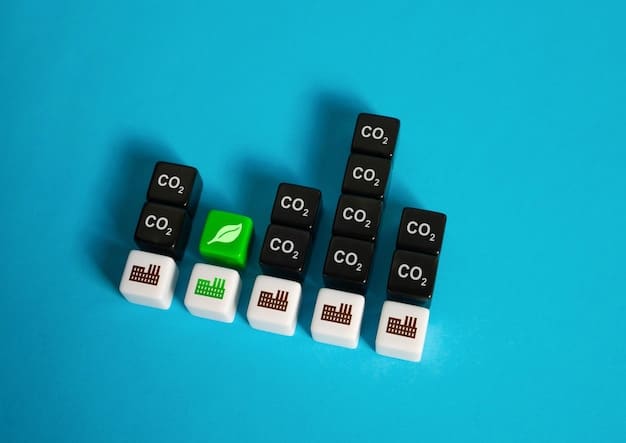Renewable Energy Surge: US Carbon Footprint Impact by 2026

A 15% increase in renewable energy consumption in the US by 2026 is projected to significantly reduce the nation’s carbon footprint by displacing fossil fuel usage, fostering technological advancements, and improving air quality, though the exact magnitude depends on several variables.
The shift towards renewable energy sources is gaining momentum globally, and the United States is no exception. As the US aims to increase its renewable energy consumption by 15% by 2026, it’s crucial to understand what are the projected effects of the 15% increase in renewable energy consumption on US carbon footprint by 2026. This initiative promises to reshape the energy landscape and significantly impact the nation’s environmental health.
Renewable Energy Expansion: An Overview
The drive to expand renewable energy consumption in the US is fueled by growing concerns about climate change and the need for energy independence. With advancements in technology and increasing economic viability, renewable sources like solar, wind, and hydro are becoming increasingly competitive with traditional fossil fuels.
Current Renewable Energy Landscape
The current energy mix in the US includes a significant portion of fossil fuels, but renewable energy sources are steadily increasing their share. Various states have set ambitious targets for renewable energy adoption, driving innovation and investment in the sector.
Federal and State Policies
Government policies play a crucial role in promoting renewable energy. Tax incentives, subsidies, and mandates such as Renewable Portfolio Standards (RPS) encourage utilities and businesses to invest in renewable energy infrastructure.
- Tax credits for solar installations lower the upfront costs for homeowners and businesses.
- Renewable Portfolio Standards require utilities to source a certain percentage of their electricity from renewable sources.
- Grants and funding programs support research and development of new renewable energy technologies.
Expanding renewable energy consumption is not just about environmental benefits; it also has significant economic implications. It is expected to create new jobs in manufacturing, installation, and maintenance, boosting local economies. Moreover, reducing reliance on imported fossil fuels enhances national energy security.

Projected Carbon Footprint Reduction
The primary goal of increasing renewable energy consumption is to reduce the US carbon footprint. By displacing fossil fuels, renewable energy sources can significantly lower greenhouse gas emissions, mitigating the impacts of climate change.
Direct Emissions Impact
Fossil fuels like coal, oil, and natural gas release large amounts of carbon dioxide (CO2) when burned for energy. Renewable energy sources, on the other hand, produce little to no direct emissions during operation.
Indirect Emission Effects
Beyond direct emissions, there are also indirect effects on the carbon footprint. For example, the manufacturing and transportation of renewable energy equipment can contribute to emissions, but these are generally much lower than those associated with fossil fuels.
- Renewable energy reduces reliance on coal-fired power plants, a major source of CO2 emissions.
- Increased use of electric vehicles powered by renewable energy further reduces transportation emissions.
- Adoption of energy-efficient technologies along with renewable energy maximizes emission reductions.
Renewable energy technologies such as solar and wind power have advanced significantly in recent years, making them more efficient and cost-effective. Efficiency improvements lead to greater energy output from the same amount of renewable resources, further reducing the need for fossil fuels. Additionally, energy storage solutions, such as batteries, are improving, allowing for better integration of intermittent renewable sources into the grid, enhancing reliability and reducing dependence on fossil fuel backup.
Economic and Technological Influences
The expansion of renewable energy is intertwined with economic and technological factors that can amplify or dampen its impact on the carbon footprint. Understanding these influences is crucial for accurate projections.
Job Creation and Economic Growth
The renewable energy sector is a significant driver of job creation. Investments in renewable energy projects lead to new jobs in manufacturing, installation, maintenance, and research, stimulating economic growth in various sectors.
Technological Advancements
Ongoing research and development efforts are continuously improving the efficiency and cost-effectiveness of renewable energy technologies. These advancements make renewable energy more competitive and accelerate its adoption.

The levelized cost of energy (LCOE) is a metric that represents the average cost of generating electricity from a specific source over its lifetime. The LCOE for renewable energy sources like solar and wind has decreased dramatically in recent years, making them economically viable alternatives to fossil fuels. Continuous improvements in energy storage technologies, such as lithium-ion batteries and pumped hydro storage, are also critical. These technologies help to address the intermittency of renewable energy sources by storing excess energy for when it’s needed, further reducing the reliance on fossil fuels and ensuring a stable energy supply.
Policy and Regulatory Frameworks
Government policies and regulations play a crucial role in shaping the renewable energy landscape. Effective policies can accelerate the transition to renewable energy, while inadequate or inconsistent policies can hinder progress.
Incentives and Subsidies
Tax credits, grants, and subsidies can significantly reduce the upfront costs of renewable energy projects, making them more attractive to investors and consumers.
Regulatory Standards
Renewable Portfolio Standards (RPS) mandate that a certain percentage of electricity be sourced from renewable sources. These standards create a guaranteed market for renewable energy, encouraging investment and innovation.
- Carbon pricing mechanisms, such as carbon taxes or cap-and-trade systems, can incentivize emissions reductions.
- Streamlined permitting processes can reduce the time and cost of developing renewable energy projects.
- Grid modernization initiatives can improve the integration of renewable energy into the electricity grid.
Challenges and Mitigation Strategies
While increasing renewable energy consumption offers numerous benefits, it also presents challenges that need to be addressed to maximize its impact on the carbon footprint.
Intermittency Issues
Renewable energy sources like solar and wind are intermittent, meaning they are not always available. This can pose challenges for grid stability and reliability.
Infrastructure Limitations
The existing electricity grid may not be able to handle the influx of renewable energy from distributed sources. Upgrades and expansions are needed to ensure that renewable energy can be efficiently transported and utilized.
To mitigate the challenges associated with intermittency, grid operators are increasingly integrating advanced forecasting techniques and demand response programs. Advanced forecasting helps predict when renewable energy sources will be available, allowing grid operators to plan accordingly. Demand response programs incentivize consumers to shift their electricity usage to times when renewable energy is abundant, further reducing the need for fossil fuel generation. Additionally, investing in grid modernization is crucial for integrating renewable energy effectively. This includes upgrading transmission lines and implementing smart grid technologies that can better manage the flow of electricity and accommodate distributed generation sources.
Future Outlook: Projections Beyond 2026
Looking beyond 2026, the trajectory of renewable energy consumption and its impact on the US carbon footprint will depend on continued policy support, technological advancements, and market dynamics. Long-term projections offer insights into potential future scenarios.
Scenario Analysis
Different scenarios, based on varying assumptions about policy and technology, can provide a range of possible outcomes for renewable energy consumption and carbon emissions.
Long-Term Goals
Many states and the federal government have set ambitious long-term goals for reducing greenhouse gas emissions. Achieving these goals will require sustained efforts to increase renewable energy consumption.
Continued policy support is essential for sustaining the growth of renewable energy. This policy support should include long-term tax incentives, funding for research and development, and regulatory frameworks that promote renewable energy deployment. Technological advancements will also play a key role, with innovations in energy storage, smart grid technologies, and renewable energy efficiency driving down costs and improving performance. As renewable energy becomes more cost-competitive and reliable, its adoption will accelerate, leading to a substantial reduction in the US carbon footprint over the long term. The combination of proactive policies, ongoing technological innovation, and market-driven adoption will pave the way for a cleaner, more sustainable energy future for the United States.
| Key Point | Brief Description |
|---|---|
| ☀️ Solar Energy Growth | Increased solar capacity reduces reliance on fossil fuels. |
| 💨 Wind Power Expansion | Wind energy contributes to a cleaner energy mix. |
| 💰 Economic Benefits | Renewable energy creates jobs and stimulates economic growth. |
| 🌱 Policy Support | Government policies drive renewable energy adoption. |
Frequently Asked Questions
▼
The primary sources of renewable energy in the US include solar, wind, hydro, geothermal, and biomass. Each source contributes differently to the overall renewable energy mix, with solar and wind showing the most rapid growth in recent years.
▼
Government policies support renewable energy through tax incentives, subsidies, Renewable Portfolio Standards (RPS), and grants for research and development. These measures encourage utilities and businesses to invest in renewable energy projects.
▼
Increasing renewable energy consumption creates new jobs in manufacturing, installation, and maintenance. It also reduces reliance on imported fossil fuels, enhancing national energy security and stimulating economic growth in the renewable energy sector.
▼
Intermittent renewable energy sources like solar and wind are not always available. This can pose challenges for grid stability and reliability. Energy storage solutions and advanced forecasting techniques are being developed to mitigate these challenges.
▼
Infrastructure limitations can be addressed through grid modernization initiatives, including upgrades to transmission lines and the implementation of smart grid technologies. These improvements allow for the efficient transport and utilization of renewable energy.
Conclusion
The projected 15% increase in renewable energy consumption in the US by 2026 is a significant step towards reducing the nation’s carbon footprint. While challenges remain, the combination of technological advancements, supportive policies, and economic incentives positions renewable energy as a key driver of a cleaner, more sustainable future.





